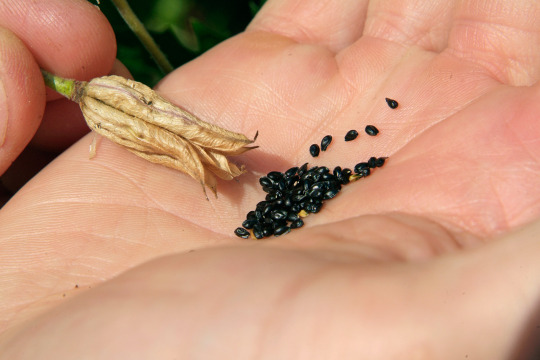#at least it hasn't been 2 months since the last post amiright
Text
What to Do Once Things Are Planted?
This is my seventh post in a series I’ll be making on how to increase biodiversity on a budget! I’m not an expert--just an enthusiast--but I hope something you find here helps!

So you’ve gotten started on making a garden to boost biodiversity! 10/10, excellent work! So, now what?
First, you’ll need to keep watering the plants--especially if you’re going through a dry season. Native plants will be more acclimated to your area’s seasonal weather, but they’ll need a helping hand while they’re getting established--especially if you’re starting with young, tender seedlings. With that in mind, if you accidentally skip out on crucial watering days, don't panic! There's been tons of times where I haven't watered for an entire summer and had perennials come back the next spring! Even this year, during a heatwave, I completely did not water my swamp milkweeds, but they're already popping back up! You may also need to go in and weed, especially if you’re seeing invasive species popping up in the garden. Invasives are no good--if you do anything, do your best to get those out as effectively and safely as possible!
If you’re needing to maintain your shrubs in spring and summer, double check to make sure there are no active bird or insect nests within them. If it’s possible to wait until later to cut your shrubs, it could be extremely beneficial.

When fall and winter come around and your plants begin to die back, don’t cut them away if you can! Many insects overwinter in the plant stems left behind as perennials die back to the roots. In addition, birds will use seed heads as a source of food over the winter. Try not to clean things up until late winter/early spring, when other food sources are beginning to come back and things are growing again. By then, the insects should be waking up and leaving the plant stems as well.

However, don’t let this discourage you from collecting seeds! Collecting seed from your plants is a great way to continue gardening at low cost, as well as making friends and encouraging others to garden by trading seeds or offering them as gifts. If you're in an area where you do need to cut back, this is a great opportunity to collect the seeds and save them for the future. You could also cut back what’s dying in the front yard and keep things to overwinter in the backyard. Some overwintering habitat is better than no overwintering habitat.
Want to know how to collect seeds from specific plants? I've found YouTube to be a great source of info for this! Knowing what you're doing and when is key to getting a viable harvest.
As your mulch begins to break down, you’ll need to keep adding more to top it off, if you can. It can get a bit repetitive, but no worries--the mulch breaking down means your soil is improving!
If possible, add to your garden! Expand, add in new things, and keep encouraging the growth of native plants. If you couldn’t add that water feature in year one, see if you can in year two! New interest in birds? Add a birdhouse, or more bird feeders. Loving the butterflies? Add plenty more nectar-rich plants, or do more research into what they lay their eggs on! Want more color? See what else you can add in! Came into some new pots to expand your flowerpot garden with? Find cool native plants to put in them! I always encourage people to start small and then expand over time, as opposed to starting big and getting overwhelmed.
Keep learning and observing native species of birds, insects, mammals, etc. See what’s coming to your yard now, and look into how you can improve things more for them on your budget. If you aren’t seeing what you were hoping, see if there’s other actions you can take that’ll attract what you’re hoping to see in your backyard habitat. Knowing more about the world around you makes it easier to know how to help the world around you. Talk to others about what you’re doing, the changes you’ve made, and the results you’ve seen! Curious neighbors? Work friends? Your closest homies? Your family? All fair game! You just might be the one who gets someone else interested in making their space a habitat for local wildlife!
That’s the end of this post! My next post is gonna be about the secret Other Thing you can do to help biodiversity--tackling invasives! Until then, I hope this advice was helpful! Feel free to reply with any questions, your success stories, or anything you think I may have forgotten to add in!
#biodiversity#solarpunk#gardening#outdoor gardening#ani rambles#out of queue#the biodiversity saga#at least it hasn't been 2 months since the last post amiright#i know its september so by this point a lot of northern hemisphere folks are winding down on gardening#buuuut winter's a good time to buy seeds for cheap! and for plotting and planning#and meanwhile the southern hemisphere will be just gearing up!#either way I hope this advice has been helpful so far!
337 notes
·
View notes